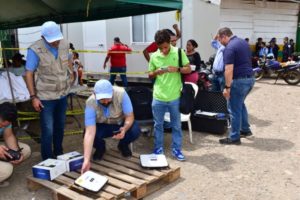ITU Emergency Telecom Roster helps restore connectivity after hurricane hits Nicaragua

A powerful tropical hurricane ripped across Nicaragua earlier this month, with torrential rains triggering life-threatening flash floods and mudslides across the Central American country.
The Category 1 storm forced 13,000 people to evacuate to shelters, according to some reports – many with only the clothes on their backs.
“The river rose one metre in ten minutes,” according to eyewitness José Domingo Enríquez of the interior town El Rama, one of the worst-affected. “It was clear the flood was coming fast, and we had to find a way to evacuate.”
Critical electricity and telecommunications services were cut shortly after the storm made landfall, leaving a million people in the dark and worried about their loved ones’ safety.
Emergency Telecom Roster deploys
To help close connectivity gaps and bolster disaster response efforts in some of the country’s hardest-hit areas, two members of ITU’s Emergency Telecommunications Roster (ETR), a group of staff volunteers from across the organization, were deployed to Nicaragua.
Their mission – the first since the roster was created – was two-fold: deliver 10 Iridium satellite phones and 10 Inmarsat Broadband Global Area Network (BGAN) terminals to help restore connectivity as soon as possible, and to provide training for local teams to use the equipment.
ITU will typically deploy equipment upon request from an ITU Member State following a natural hazard, after which the team aims to respond within 24 to 48 hours.
In Nicaragua’s case, the request came via the telecom regulator, TELCOR, and SINAPRED, the country’s national disaster management agency.
Once on the ground, roster members Mario Castro Grande and Hani Alser met with government officials to deliver the equipment, train Telcor and SINAPRED responders, and assess the damage.
According to Alser, local officials were extremely welcoming and highly appreciative of both the equipment and the expertise provided.
“Having at least one technical person and another that can communicate in the local language and knows the customs is key to a successful ETR mission,” added Castro Grande.
Beyond bringing equipment
Delivering critical emergency telecom equipment is only part of ITU’s work in this domain.
The UN agency for information and communication technologies (ICTs) also supports the development and implementation of National Emergency Telecommunication Plans (NETP) among other regulatory and legal disaster preparedness frameworks.
“Nicaragua had a draft NETP back in 2014, but apparently it was shelved,” explained Castro Grande. “Our mission also served as a timely reminder that they should look at it again, with the objective of finalizing it.”
The ITU team also urged national authorities to implement an early warning system. This was another aspect of the mission, said Castro Grande. “We offered some information on appropriate available systems for developing countries, such as cell broadcasting, and informed them on legislative models they could look at.”
The ability of cell broadcast technology to push messages without being affected by traffic load makes it useful during emergencies when data traffic spikes, and regular SMS and voice calls tend to congest mobile networks.
“About 95 per cent of the global population is covered by a broadband network, with 5.7 billion mobile subscriptions, meaning at least 70 per cent of the world is connected,” Castro Grande pointed out. “Cell broadcasting technology should be used to its fullest potential to warn people ahead of disaster.”
Earlier this year, Secretary-General Antonio Guterres announced the United Nations would “spearhead new action to ensure every person on Earth is protected by early warning systems within five years.” ITU is supporting this initiative, which is led by the World Meteorological Organization (WMO).

